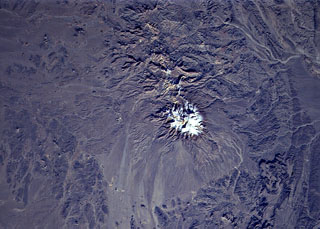Report on Taftan (Iran) — October 2004
Bulletin of the Global Volcanism Network, vol. 29, no. 10 (October 2004)
Managing Editor: Richard Wunderman.
Taftan (Iran) October 2003 visit found passive degassing; petrography of andesite lava sample
Please cite this report as:
Global Volcanism Program, 2004. Report on Taftan (Iran) (Wunderman, R., ed.). Bulletin of the Global Volcanism Network, 29:10. Smithsonian Institution. https://doi.org/10.5479/si.GVP.BGVN200410-232050
Taftan
Iran
28.6°N, 61.13°E; summit elev. 3940 m
All times are local (unless otherwise noted)
When visited in October 2003, Taftan's behavior was similar to that reported in July 1999 (BGVN 24:10), consisting of a fumarolic zone on the SE cone's W side, ~ 10 m2 in area, emitting steam and SO2 gas, and depositing sulfur. Degassing was clearly visible from the refuge at 3,250 m elevation. A mixture of sulfur and clay derived from highly altered lavas gave a snowy appearance to the summit. This snowy appearance was also noted in July 1999 (BGVN 24:10). Close to the refuge, a warm acid spring generated deep yellow deposits along the ditch down the valley for more than 1 km. A chemical analysis showed that the deposits were predominantly iron salts.
A surface lava sample, taken on 30 October 2003 from just below the refuge on the volcano's W slopes, was judged to be relatively young. George Morris analyzed the sample by X-ray fluorescence spectroscopy (XRF) and described the sample as andesite. This was the first known chemical analysis for Taftan rocks. In addition to the sampled lava flow, thick deposits of ignimbrite appeared in the walls of a deep gorge followed by the trail ascending to the refuge (at ~ 2,500 m elevation). It looked fresh and was judged to be Holocene in age.
Petrography of the lava sample. The sample is phenocryst rich (by volume, ~ 40-50% phenocrysts) in a microcrystalline to cryptocrystalline groundmass. Plagioclase is the predominant phenocryst phase (30-40%) with hornblende (< 5%), pyroxene (< 1%), opaque Fe-Ti oxide phases (< 1%), and trace amounts of biotite. Microxenoliths (1-3 mm in size) were observed, contributing < 2% volume to the whole rock.
Plagioclase phenocrysts invariably show complex zoning, but can be roughly divided into four groups. Euhedral plagioclase (0.5-1 mm long) show fine oscillatory zoning as well as internal dissolution and overgrowth surfaces. They are invariably euhedral but show no sieve-textured zones or dissolution channeling. Sieve-texture mantled plagioclase (0.5-5 mm long) can either have an un-zoned anhedral or an oscillatory zoned core. This is mantled with a zone of fine sieve-textured plagioclase of variable width, then overgrown by an un-sieved rim that may be oscillatory zoned. Inclusion-rich zones were observed running parallel to the sieve-textured zones within the cores of larger phenocrysts. Sieve-cored plagioclase (0.3-1 mm long) contain a completely sieve-textured core overgrown (normally) with an oscillatory zoned rim. These are generally smaller than the sieve-texture mantled plagioclase; however, the thicker un-sieved rims suggest that they form a distinct group rather than being a smaller version of the above. Small euhedral lath shaped plagioclase (< 0.3 mm) are common in the groundmass.
Hornblende occurs as lozenge-shaped crystals 0.2-1.5 mm long. These are invariably rimmed by thick reaction zones dominated by opaque oxides. These reaction zones can sometimes completely replace the original phenocryst.
Rare euhedral crystals of clinopyroxene were observed as phenocrysts. Similar pyroxenes were observed both in clots (with plagioclase) and in microxenoliths. Opaque oxide phases were observed as euhedral to anhedral phenocrysts 0.2-0.3 mm in diameter but account for less than 1% of the whole rock. Trace amounts of biotite were also observed; similar biotite was seen in microxenoliths. Most microphenocrysts contained a microcrystalline mass dominated by opaque oxides. Where less altered examples survive, the mineralogy is dominated by subhedral plagioclase and euhedral clinopyroxene, the pyroxene often partially altered to biotite and oxide phases. Crystal faces on feldspar in contact with the groundmass show sieve-textured reaction mantles, which is absent on crystal faces internal to the microxenoliths.
Interpretation. The phenocryst assemblage of the lava sample suggests multiple phenocryst sources and disequilibrium between mineral phases and groundmass, typical of stratovolcanoes. The correspondence of some phenocryst phases with mineral phases in microxenoliths suggest that at least some of the phenocrysts were inherited during the assimilation of country rock, while the oscillatory zoning, sieve-textured cores and mantles, and multiple dissolution surfaces in feldspars indicates that other phenocrysts have undergone long and complex magmatic histories.
Setting and summit elevation. Taftan is in eastern Iran, 100 km SSE of the city of Zahedan and 50 km W of the Pakistan border. Several necks, representing erosional remnants of cinder cones, rise from the plain W from Taftan, as well as a second stratovolcano, Buzman (~ 3,500 m summit elevation), which remains largely unknown.
The summit elevation is listed in the Catalog of Active Volcanoes of the World (Gansser, 1964) as 4,050 m. Jean Sesiano found (presumably more current) Iranian maps with the volcanically active SE summit shown as 3,940 m, and the dissected NW summit, as 3,840 m.
Reference. Gansser, A., 1964, Catalog of the Active Volcanoes and Solfatara Fields of Iran; Rome, IAVCEI, part XVII-Appendix, p. 1-20.
Geological Summary. Taftan is a strongly eroded andesitic stratovolcano with two prominent summits. The volcano was constructed along the Makran-Chagai Arc in SE Iran. The higher SE summit cone has been the source of lava flows, as well as of highly active, sulfur-encrusted fumaroles. In January 1902 the volcano was reported to be smoking heavily for several days, with occasional strong night-time glow. A lava flow was reported in 1993, but may have been a mistaken observation of a molten sulfur flow. Despite these reports there is no clear evidence for Holocene activity. The youngest date obtained by Pang et al. (2014), using U-Pb on a zircon, was about 800 ka. Biabangard and Moradian (2008) obtained K-Ar dates around 700 ka.
Information Contacts: Jean Sesiano and George Morris, Earth Sciences Section, Mineralogy Dept, University of Geneva, 13 rue des Maraîchers, 1205 Genève, Switzerland

